Sight Word Easter Egg Hunt

This post may contain affiliate links; please see our terms of use for details.
When I was a kindergarten and first-grade teacher, sight word memorization was a big deal. I knew that my students who struggled with reading often started to take off after memorizing sight words. Reading with more fluency and less struggle always makes a child feel more confident.
Trying to help your child memorize a long list of sight words can feel daunting. Long sessions of reviewing flashcards can start to wear you down. Both child and parent can begin to dread memorizing sight words.
Thankfully, it doesn’t need to be such a dull task. In our home, we try to create games and activities out of sight word memorization. Dyslexia word games, like our Valentine’s Sight Word Game, make memorization enjoyable and effective.
If you have a child who loves hide and seek, they’ll love playing this Sight Word Easter Egg Hunt game. Your child will want to play again and again. Grab some easter eggs and your child’s sight word list and follow along!
Sight Word Easter Egg Hunt: What You’ll Need
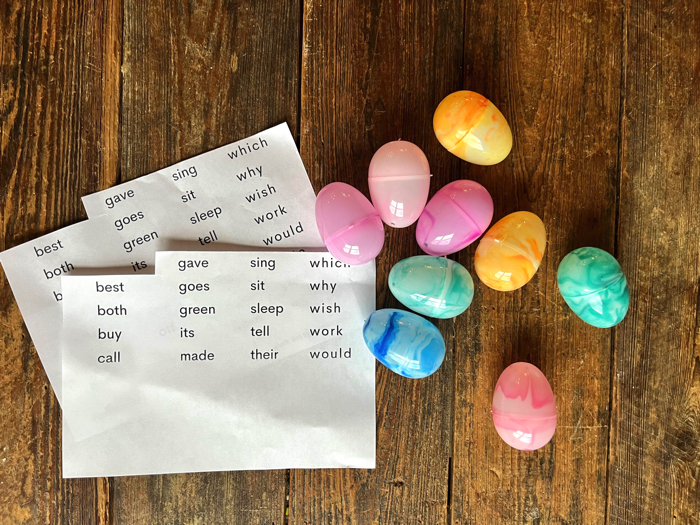
This game uses only a few items and you can simplify it as much as you want to fit your time constraints and needs.
Here’s what I used to create this sight word egg hunt:
Materials:
- Plastic Easter Eggs
- Sight word list
- Empty Egg Cartons
- Glue
Setup:
Before you play the game with your child, you’ll want to assemble a few items. Follow these steps for a simple setup:
Step 1: Print your child’s sight word list twice and cut out each word. (I love using my scrapbook paper cutter. Using it to cut straight lines is much faster than by hand.)
Keep the two sets separate as you cut so you don’t have to sort them after cutting.
Hint: If you aren’t sure what sight words your child should memorize, you might try a Dolch sight word list. These lists are divided by grade and will give you a great starting point.

Step 2: Open the plastic Easter eggs and, using only one of the sets of words, put one word in each egg. Close the eggs and set aside.
Step 3: Open the empty egg cartons and, using the other set of words, glue one word in each egg dimple. Each egg should match up to a dimple that contains the same word.
Time to Play
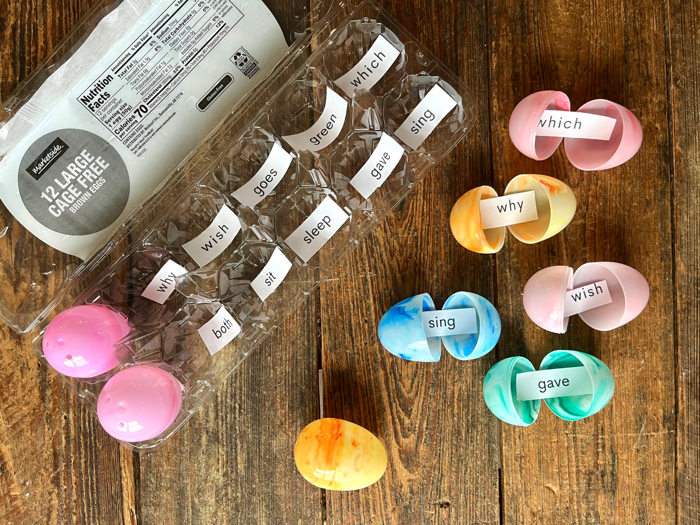
Hooray! It’s time to play. There are many ways you can use this set to play a sight word game.
Each game includes different skills but still accomplishes sight word memorization. Here are a few ideas:
Easter Egg Hunt
This is our favorite way to play with this set. To create an egg hunt, hide the eggs around the house. I like hiding them upstairs and downstairs to get my kids moving.
I don’t hide them in difficult places because the goal isn’t to challenge them during the hunt. You don’t want to frustrate your child by making them search too long. Have your child collect the eggs in a bag or basket.
When they are finished, they’ll open an egg, read the word, and then place it in the correct egg carton dimple. They’ll continue until all eggs have been opened and placed.
Basket of Eggs
If you’re playing in a classroom setting, this might be an easier option instead of hiding the eggs around the room. This is also one way to make the activity a group game.
Place all of the eggs in a basket. Give each child an egg carton with the sight words glued in the dimples. Each child takes a turn reaching their hand in the basket and pulling out an egg.
When a child pulls out the egg, they’ll open it and read the word. If they have that word in their egg carton, they keep it. If they don’t have the word, it goes back in the basket and gets mixed in.
The children should continue taking turns until someone fills their egg carton and wins that round.
Fill the Eggs
Another simple way to play with this set is to have your child pretend to be an Easter egg filler. Tell them they have to work at the egg factory today to fill Easter eggs for children. Give your child a pile of sight words, empty eggs, and egg cartons with the sight words inside.
Your child’s job is to pick out a word, read it, put it in an egg, and then match it to its spot. To make the game even more fun, include small candies as well. Your child can select a word and a piece of candy to put in each egg.
What other ways can I use this Easter Egg Hunt Set?
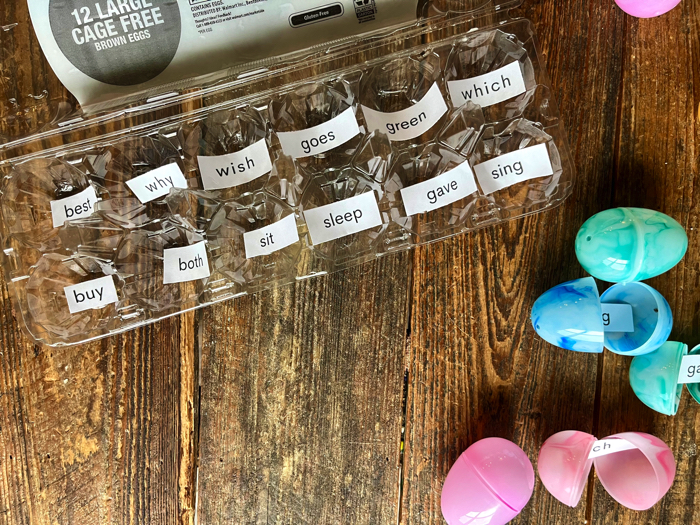
With the eggs and egg cartons, you can create a variety of educational games. Here are a few simple ideas:
Letter Match
Preschool literacy activities should be both educational and engaging. Whether making tactile alphabet cookies or playing vocabulary games, children can learn many skills through play. This activity reinforces letter recognition skills through an egg-themed game.
Instead of printing sight words, print two sets of the alphabet—one uppercase and one lowercase. Place the uppercase letters inside the eggs and glue the lowercase letters in the dimples of the egg cartons. Have your child hunt for the eggs and match the uppercase letters to the lowercase letters.
Word Building
Building CVC words is a great way to support beginning readers. Playing fun games like our CVC word snowball toss will keep reading practice from getting dull.
Print and cut letters and place them in the plastic eggs. Separate the eggs containing vowels by either marking the eggs or using eggs of one color. This will allow your child to build the words easily.
Have your child select two consonant eggs and one vowel egg. Placing the vowel egg in the middle, let your child open the eggs and sound out the word they created.
It’s okay if your child creates a nonsense word. This is still great practice and will build the phonemic skills needed for fluent reading.
Name Spelling
My three-year-old is currently learning to spell her name. To help her memorize the letters in her name, we develop rhymes, songs, and games that use her letters. Here’s how you can use the eggs to practice your child’s name.
Fill eggs with the letters in your child’s name and place them in order. Have your child open the eggs and name the letters. Next, close the eggs, mix them up, and have your child open them again and put the letters in the correct order.
What other ways can I teach sight words?
Sight words can be taught in the car, at the house, while grocery shopping, or virtually anywhere with your child. We’ve found that the Jack Hartmann Sight Word Songs are great for practicing in the car or while waiting at the doctor’s office. My kids love to read the words and sing along.
You can also have your child read sight words while shopping at the grocery store. You’ll find many small sight words on packaging, displays, or store signs. The same is true for signs as you drive down the road.
On warm, sunny days, my kids and I like to take school outdoors. We’ll often practice sight words with chalk on the sidewalk or write them in a salt tray on the lawn.
Are there other benefits to playing this activity?
As your child races to collect eggs and find the match, they’ll be sharpening these skills:
Gross Motor Skills
Running and climbing stairs are just a couple of many gross motor milestones. Allowing your child to practice hopping, running, skipping, climbing, and other big muscle movements can help improve a gross motor delay. Try placing the eggs in places requiring them to safely jump, climb, or crawl.
Fine Motor Skills
After your child collects the eggs, they’ll need to open them. Easter eggs serve as perfect toys for fine motor development. The pinching and pulling motion helps strengthen the muscles needed for fine motor activities.
What other ways can I enrich this activity?
- 111
- Hardcover Book
- Wallace, Adam (Author)
- English (Publication Language)
To continue the egg-filled fun, consider trying one of these Easter activities:
- Try one of these glowing easter egg activities
- Create some tactile easter crafts
- Read the book How to Catch the Easter Bunny by Adam Wallace
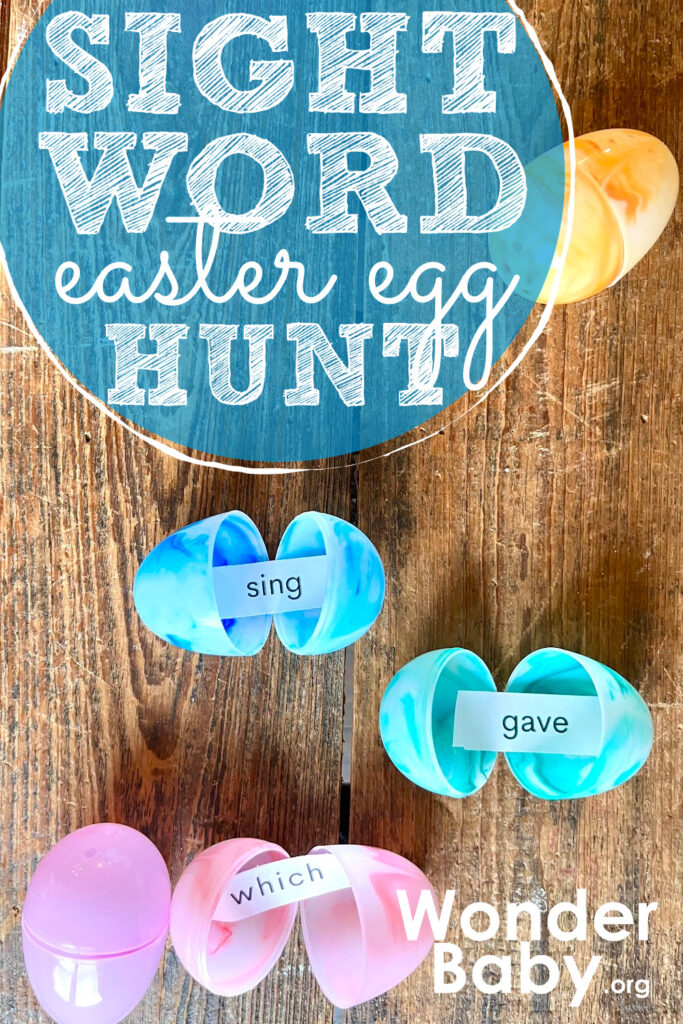
Related Posts
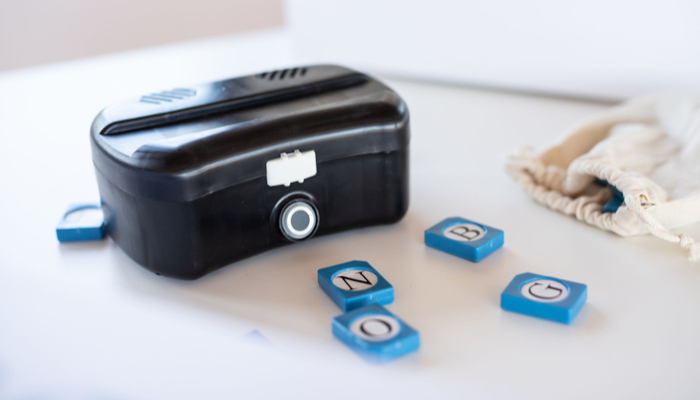
Braille and Literacy
Making Braille Fun: Introducing Handi Exceller’s Innovative Learning Tools for Blind Students
Handi Exceller was born from a simple idea: learning braille should be both fun and accessible. The company creates interactive and gamified ways to teach braille.

Braille and Literacy, Toys, Visual Impairment
24 Braille Toys for Kids Who are Blind
Everything from alphabet blocks to raised line coloring pages and activity books to puzzles to card and board games... and so much more! And it's all in braille ready for...

Holiday Crafts and Ideas
Should Parents Lie to Their Kids About Santa Claus?
Should parents lie about Santa? Find out how to balance trust, magic, and holiday traditions right here!
